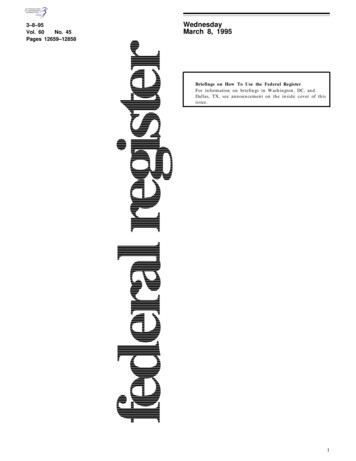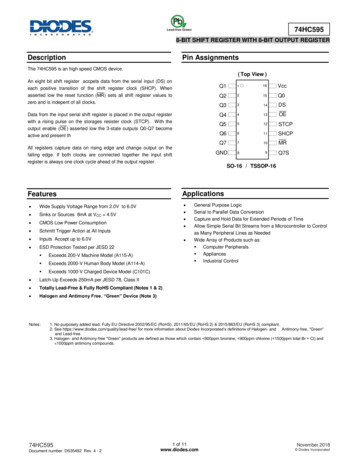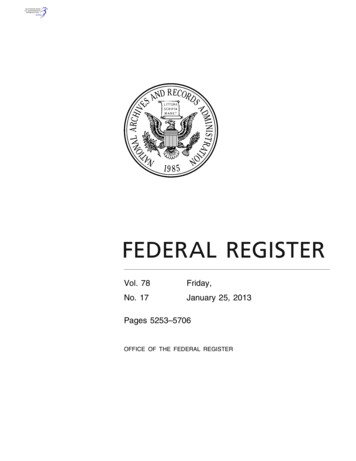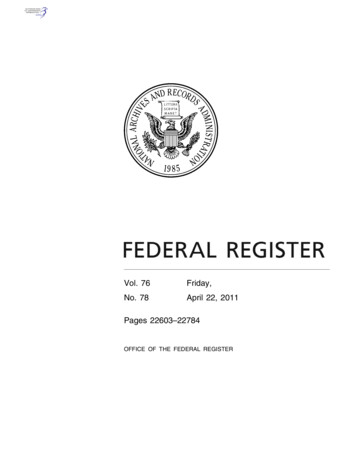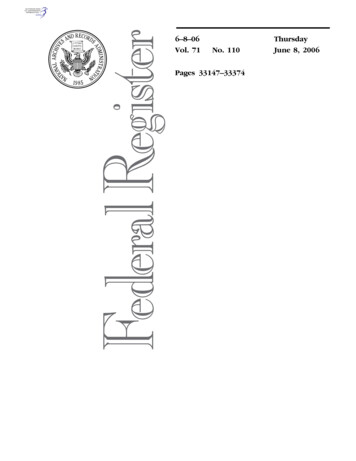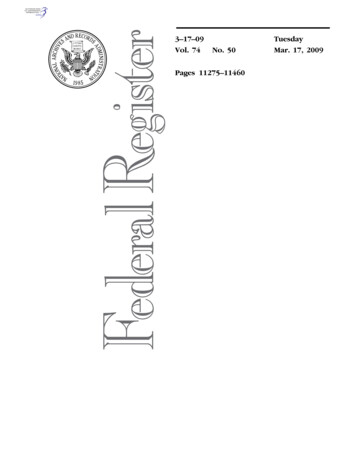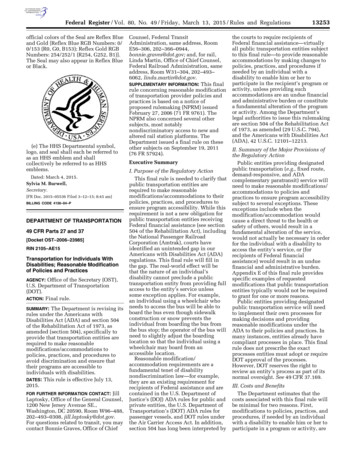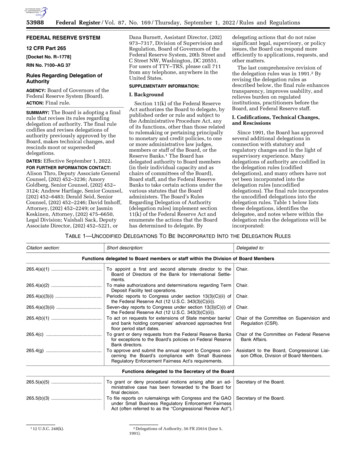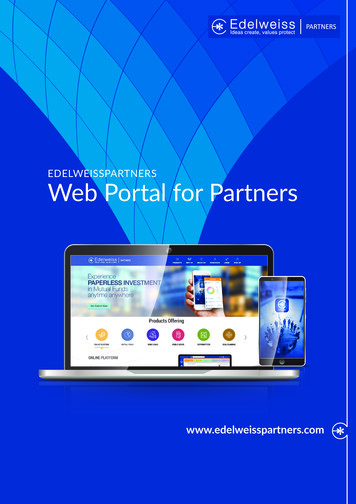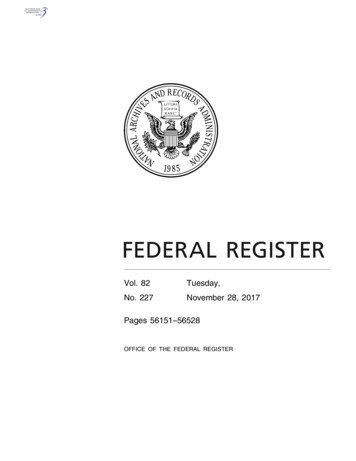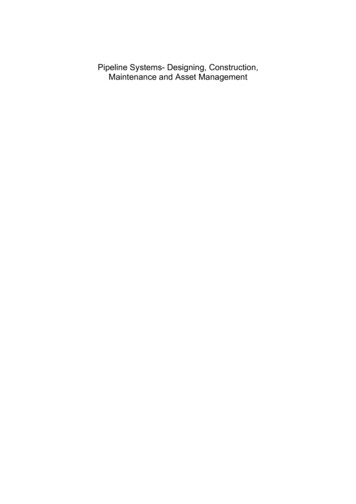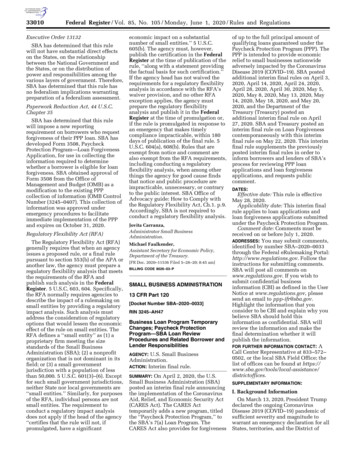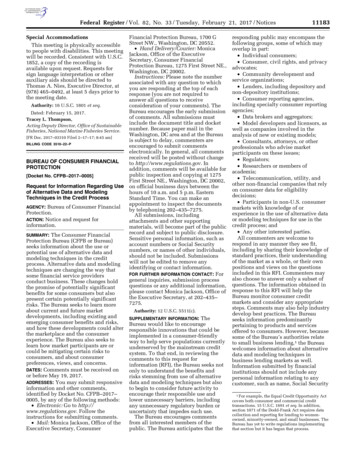
Transcription
Federal Register / Vol. 82, No. 33 / Tuesday, February 21, 2017 / NoticesSpecial AccommodationsThis meeting is physically accessibleto people with disabilities. This meetingwill be recorded. Consistent with U.S.C.1852, a copy of the recording isavailable upon request. Requests forsign language interpretation or otherauxiliary aids should be directed toThomas A. Nies, Executive Director, at(978) 465–0492, at least 5 days prior tothe meeting date.Authority: 16 U.S.C. 1801 et seq.Dated: February 15, 2017.Tracey L. Thompson,Acting Deputy Director, Office of SustainableFisheries, National Marine Fisheries Service.[FR Doc. 2017–03310 Filed 2–17–17; 8:45 am]BILLING CODE 3510–22–PBUREAU OF CONSUMER FINANCIALPROTECTION[Docket No. CFPB–2017–0005]Request for Information Regarding Useof Alternative Data and ModelingTechniques in the Credit ProcessBureau of Consumer FinancialProtection.ACTION: Notice and request forinformation.AGENCY:The Consumer FinancialProtection Bureau (CFPB or Bureau)seeks information about the use orpotential use of alternative data andmodeling techniques in the creditprocess. Alternative data and modelingtechniques are changing the way thatsome financial service providersconduct business. These changes holdthe promise of potentially significantbenefits for some consumers but alsopresent certain potentially significantrisks. The Bureau seeks to learn moreabout current and future marketdevelopments, including existing andemerging consumer benefits and risks,and how these developments could alterthe marketplace and the consumerexperience. The Bureau also seeks tolearn how market participants are orcould be mitigating certain risks toconsumers, and about consumerpreferences, views, and concerns.DATES: Comments must be received onor before May 19, 2017.ADDRESSES: You may submit responsiveinformation and other comments,identified by Docket No. CFPB–2017–0005, by any of the following methods: Electronic: Go to http://www.regulations.gov. Follow theinstructions for submitting comments. Mail: Monica Jackson, Office of theExecutive Secretary, Consumersradovich on DSK3GMQ082PROD with NOTICESSUMMARY:VerDate Sep 11 201417:15 Feb 17, 2017Jkt 241001Financial Protection Bureau, 1700 GStreet NW., Washington, DC 20552. Hand Delivery/Courier: MonicaJackson, Office of the ExecutiveSecretary, Consumer FinancialProtection Bureau, 1275 First Street NE.,Washington, DC 20002.Instructions: Please note the numberassociated with any question to whichyou are responding at the top of eachresponse (you are not required toanswer all questions to receiveconsideration of your comments). TheBureau encourages the early submissionof comments. All submissions mustinclude the document title and docketnumber. Because paper mail in theWashington, DC area and at the Bureauis subject to delay, commenters areencouraged to submit commentselectronically. In general, all commentsreceived will be posted without changeto http://www.regulations.gov. Inaddition, comments will be available forpublic inspection and copying at 1275First Street NE., Washington, DC 20002,on official business days between thehours of 10 a.m. and 5 p.m. EasternStandard Time. You can make anappointment to inspect the documentsby telephoning 202–435–7275.All submissions, includingattachments and other supportingmaterials, will become part of the publicrecord and subject to public disclosure.Sensitive personal information, such asaccount numbers or Social Securitynumbers, or names of other individuals,should not be included. Submissionswill not be edited to remove anyidentifying or contact information.FOR FURTHER INFORMATION CONTACT: Forgeneral inquiries, submission processquestions or any additional information,please contact Monica Jackson, Office ofthe Executive Secretary, at 202–435–7275.Authority: 12 U.S.C. 5511(c).TheBureau would like to encourageresponsible innovations that could beimplemented in a consumer-friendlyway to help serve populations currentlyunderserved by the mainstream creditsystem. To that end, in reviewing thecomments to this request forinformation (RFI), the Bureau seeks notonly to understand the benefits andrisks stemming from use of alternativedata and modeling techniques but alsoto begin to consider future activity toencourage their responsible use andlower unnecessary barriers, includingany unnecessary regulatory burden oruncertainty that impedes such use.The Bureau encourages commentsfrom all interested members of thepublic. The Bureau anticipates that theSUPPLEMENTARY INFORMATION:PO 00000Frm 00013Fmt 4703Sfmt 470311183responding public may encompass thefollowing groups, some of which mayoverlap in part: Individual consumers; Consumer, civil rights, and privacyadvocates; Community development andservice organizations; Lenders, including depository andnon-depository institutions; Consumer reporting agencies,including specialty consumer reportingagencies; Data brokers and aggregators; Model developers and licensors, aswell as companies involved in theanalysis of new or existing models; Consultants, attorneys, or otherprofessionals who advise marketparticipants on these issues; Regulators; Researchers or members ofacademia; Telecommunication, utility, andother non-financial companies that relyon consumer data for eligibilitydecisions; Participants in non-U.S. consumermarkets with knowledge of orexperience in the use of alternative dataor modeling techniques for use in thecredit process; and Any other interested parties.All commenters are welcome torespond in any manner they see fit,including by sharing their knowledge ofstandard practices, their understandingof the market as a whole, or their ownpositions and views on the questionsincluded in this RFI. Commenters mayalso choose to answer only a subset ofquestions. The information obtained inresponse to this RFI will help theBureau monitor consumer creditmarkets and consider any appropriatesteps. Comments may also help industrydevelop best practices. The Bureauseeks information predominantlypertaining to products and servicesoffered to consumers. However, becausesome of the Bureau’s authorities relateto small business lending,1 the Bureauwelcomes information about alternativedata and modeling techniques inbusiness lending markets as well.Information submitted by financialinstitutions should not include anypersonal information relating to anycustomer, such as name, Social Security1 For example, the Equal Credit Opportunity Actcovers both consumer and commercial credittransactions. 15 U.S.C. 1691 et seq. In addition,section 1071 of the Dodd-Frank Act requires datacollection and reporting for lending to womenowned, minority-owned, and small businesses. TheBureau has yet to write regulations implementingthat section but it has begun that process.E:\FR\FM\21FEN1.SGM21FEN1
11184Federal Register / Vol. 82, No. 33 / Tuesday, February 21, 2017 / Noticessradovich on DSK3GMQ082PROD with NOTICESnumber, address, telephone number, oraccount number.For the purposes of this RFI, wedefine the following terms. None ofthese definitions should be construed asstatutory or regulatory definitions ordescriptions of statutory or regulatorycoverage. ‘‘Traditional data’’ refers to dataassembled and managed in the corecredit files of the nationwide consumerreporting agencies, which includestradeline information (including certainloan or credit limit information, debtrepayment history, and account status),and credit inquiries, as well asinformation from public records relatingto civil judgments, tax liens, andbankruptcies. It also refers to datacustomarily provided by consumers aspart of applications for credit, such asincome or length of time in residence. ‘‘Alternative data’’ refers to any datathat are not ‘‘traditional.’’ We use‘‘alternative’’ in a descriptive ratherthan normative sense and recognizethere may not be an easily definable linebetween traditional and alternative data. ‘‘Traditional modeling techniques’’refers to statistical and mathematicaltechniques, including models,algorithms, and their outputs, that aretraditionally used in automated creditprocesses, especially linear and logisticregression methods. ‘‘Alternative modeling techniques’’refers to all other modeling techniquesthat are not ‘‘traditional,’’ including butnot limited to decision trees, randomforests, artificial neural networks, knearest neighbor, genetic programming,‘‘boosting’’ algorithms, etc. We use‘‘alternative’’ in a descriptive ratherthan normative sense and recognize thatthere may not be an easily definable linebetween traditional and alternativemodeling techniques. ‘‘The credit process’’ refers to allthe processes and decisions made by thecreditor during the full lifecycle of thecredit product, including marketing,pre-screening, fraud prevention,application procedures, underwriting,account management, creditauthorization, the setting of pricing andterms, as well as the renewal,modification, or refinancing of existingcredit, and the servicing and collectionof debts.Part A: Traditional Automated CreditProcess and Its AlternativesMost of today’s automated decisionsin the credit process use traditionalmodeling techniques that rely upontraditional data elements as inputs.When lenders make decisions aboutconsumers relating to applications forcredit, increases or reductions in creditVerDate Sep 11 201417:15 Feb 17, 2017Jkt 241001lines, extensions of new offers of credit,or other decisions in the credit process,lenders typically evaluate consumersusing a standard set of information thatincludes consumer-supplied data (suchas income, assets and, if secured, anycollateral) and other traditional datasupplied by one or more of thenationwide consumer reportingagencies. Many lenders base theirdecisions, in whole or in part, on scoresusing traditional data as inputs andgenerated from commercially-available,third-party models such as one of themany developed by FICO orVantageScore Solutions. Other lendersmay base their decisions, in whole or inpart, on proprietary scoring algorithmsthat use traditional data, and perhapsscores from these third-party models, aswell as consumer-supplied information,as inputs. In addition to using commoninputs, there is similar consistency inthe modeling techniques used togenerate these automated decisionengines. They have predominantly beendeveloped using multivariate regressionanalysis to correlate past credit historyand current credit usage attributes toconsumer credit outcomes to determinewhether, based on the performance ofother previous consumers who hadsimilar attributes at the time credit wasextended, it is likely that the consumerbeing evaluated will default on orbecome seriously delinquent on the loanwithin a certain period of time (often 1–2 years). These traditional data andmodeling techniques have facilitated thestandardization and automation of thecredit process, leading to efficiencies inthe provision of credit over the past fewdecades.Yet the use of traditional data andmodeling techniques has left someimportant gaps in access to mainstreamcredit for certain consumer groups andsegments. The Bureau estimates that 26million Americans are ‘‘creditinvisible,’’ meaning that they have nofile with the major credit bureaus, whileanother 19 million are ‘‘unscorable’’because their credit file is either too thinor too stale to generate a reliable scorefrom one of the major credit scoringfirms.2 Most of these 45 millionAmericans are underserved by themainstream credit system and they aredisproportionately Black and Hispanic,low-income, or young adults. Somepopulations, like those recentlywidowed or divorced or recentimmigrants, have difficulty accessingthe mainstream credit system because2 CFPB, Data Point: Credit Invisibles (May 2015),available at http://files.consumerfinance.gov/f/201505 cfpb data-point-credit-invisibles.pdf(figures are from 2010 Census).PO 00000Frm 00014Fmt 4703Sfmt 4703they have not established a long enoughcredit history on their own or in thiscountry. Some underserved consumersinstead resort to high-cost products thatmay not help them build credit history.Several commentators have suggestedthat alternative data and modelingtechniques could address this problemand reach some of the millions ofconsumers currently shut out of themainstream credit system and enableothers to obtain more favorable pricingbased on more refined assessments oftheir risks.3 Discussions point to thewide array of other data sources beyondtraditional credit files that could beused to assess the creditworthiness ofborrowers, including so-called ‘‘bigdata.’’ 4 In addition, increasedcomputing power and the expanded useof machine learning to mine massivedatasets could potentially identifyinsights not otherwise discoverablethrough traditional methods. Theapplication of alternative data andmodeling techniques might alsoimprove decisions in the credit processby improving the predictiveness ofcredit-related models, by lowering thecosts of sourcing and analyzing data, orthrough other process improvementssuch as faster decisions.If these claimed benefits prove valid,the use of alternative data and modelingtechniques could significantly reshapethe consumer (and business) creditmarket. Potentially millions ofconsumers previously locked out ofmainstream credit could become eligiblefor credit products that might help thembuy a car or a home. An increasingability for lenders to accurately assessrisk could reduce the price of credit forthose who are shown to be good risks(although it could increase the price ofcredit for those shown to be worserisks), and might even reduce theoverall average price of credit for thosewho qualify for credit. The process of3 See, e.g., PERC, Give Credit Where Credit Is Due:Increasing Access To Affordable Mainstream CreditUsing Alternative Data (Dec. 2006), available recredit-is-due/; CFSI, The Predictive Value ofAlternative Credit Scores (Nov. 2007), available e-Predictive-Value-of-Alternative-Credit-Scores;4 ‘‘Big data’’ is a distinct concept from alternativedata, though some alternative data may have theattributes generally ascribed to ‘‘big data.’’ In theFTC’s words, ‘‘A common framework forcharacterizing big data relies on the ‘three Vs,’ thevolume, velocity, and variety of data, each of whichis growing at a rapid rate as technological advancespermit the analysis and use of this data in ways thatwere not possible previously.’’ FTC, Big Data: ATool for Inclusion or Exclusion? Understanding theIssues (Jan. 2016), available at 21FEN1
Federal Register / Vol. 82, No. 33 / Tuesday, February 21, 2017 / Noticessradovich on DSK3GMQ082PROD with NOTICESapplying for credit could become morestreamlined and convenient.At the same time, other commentatorshave pointed out that alternative dataand modeling techniques could presentrisks for consumers. These risks includebut are not limited to potential issueswith the accuracy of alternative dataand modeling techniques; the lack oftransparency, control, and ability tocorrect data that might result from theiruse; potential infringements onconsumer privacy; and the risk thatcertain data could dampen socialmobility, result in discriminatoryoutcomes, or otherwise disadvantagecertain groups, characteristics, orbehaviors.The Bureau seeks to learn more aboutthese potential benefits and risks. Infurther educating ourselves and thepublic, the Bureau seeks to encourageresponsible uses of alternative data andmodeling techniques while mitigatingthe various risks.Part B: Alternative Data and ModelingTechniquesBased on its research to date, theBureau is aware of a broad range ofalternative data and modelingtechniques that firms are either using orcontemplating. These innovations maybe in different stages of developmentand market adoption. As set forthbelow, the Bureau seeks moreinformation about the stages ofdevelopment and extent of adoption ofthese innovations. In some cases theyare broadly used by a wide range ofmarket participants, while others are inearlier stages of development. Somemay be used often in fraud detection ormarketing, for example, but rarely inunderwriting. Some have beendeveloped by established dataaggregators or model developers wholicense their technologies or‘‘platforms’’ to lenders; others have beendeveloped for proprietary use byestablished lenders; and still others arebeing used by early stage lenders as abasis for lending at lower cost orprofitably in certain channels or toconsumer segments that establishedlenders have not traditionally served orcan only serve at higher cost. Among thenumerous online or marketplace lendersthat have formed over the past fewyears, many have identified use ofproprietary alternative data or machinelearning techniques as central to theirbusiness strategies and comparativeadvantage.Just how ‘‘alternative’’ or‘‘traditional’’ certain data or modelingtechniques are depends on one’sperspective. Labeling data or modelingtechniques as ‘‘alternative’’ is notVerDate Sep 11 201417:15 Feb 17, 2017Jkt 241001intended as a normative judgment, butto describe the fact that they have notcustomarily been used in decisions inthe credit process. Any mention in thisdocument of particular types ofalternative data or modeling techniquesshould not be construed as endorsementor disapproval by the Bureau.Data that some have labeled‘‘alternative’’ include but are not limitedto the following: 5 Data showing trends or patterns intraditional loan repayment data. Payment data relating to non-loanproducts requiring regular (typicallymonthly) payments, such astelecommunications, rent, insurance, orutilities. Checking account transaction andcashflow data and information about aconsumer’s assets, which could includethe regularity of a consumer’s cashinflows and outflows, or informationabout prior income or expense shocks. Data that some consider to berelated to a consumer’s stability, whichmight include information about thefrequency of changes in residences,employment, phone numbers or emailaddresses. Data about a consumer’seducational or occupational attainment,including information about schoolsattended, degrees obtained, and jobpositions held. Behavioral data about consumers,such as how consumers interact with aweb interface or answer specificquestions, or data about how they shop,browse, use devices, or move about theirdaily lives. Data about consumers’ friends andassociates, including data aboutconnections on social media.Modeling techniques that some havelabeled ‘‘alternative’’ include but are notlimited to the following: Decision trees (or sets of decisiontrees, such as ‘‘random forests’’). Artificial neural networks. Genetic programming. ‘‘Boosting’’ algorithms. K-nearest neighbors.Given the rapidly evolving creditmarket landscape, the Bureau is eager tolearn more about types of alternativedata and modeling techniques,including but not limited to those listedabove, and their uses and impacts.5 This list is purely descriptive, and nothingshould be implied from the inclusion or exclusionof any data.PO 00000Frm 00015Fmt 4703Sfmt 470311185Part C: Potential Benefits and RisksAssociated With Use of AlternativeData and Modeling Techniques in theCredit ProcessPrior Research and Interest inAlternative Data and ModelingTechniquesThe Bureau is aware that severalmarket participants,6 consumeradvocates,7 regulators, and othercommentators have identified the use ofalternative data and modelingtechniques as a source of potentialopportunities and risks. Withoutseeking to summarize the full range ofprior work, we note here a few relevantrecent publications by other Federalentities.8 In September 2014, theFederal Trade Commission (FTC) held apublic workshop on the topic of ‘‘BigData’’ and subsequently published areport in January 2016 entitled ‘‘BigData: A Tool for Inclusion orExclusion?’’ 9 This report outlinedpotential consumer benefits and risksbroadly, rather than those specific tocredit decisions. The FTC found that bigdata ‘‘is helping target educational,credit, healthcare, and employmentopportunities to low-income andunderserved populations’’ but couldalso contain ‘‘potential inaccuracies andbiases [that] might lead to detrimentaleffects, including discrimination, forlow-income and underservedpopulations.’’ 10Similarly, the Department of theTreasury’s May 2016 report onmarketplace lending referenced the use6 See, e.g., FICO, ‘‘Can Alternative Data ExpandCredit Access?’’ (Dec. 2015), available at andcredit-access; TransUnion, ‘‘The State ofAlternative Data,’’ available at ofalternative-data.pdf.7 See, e.g., National Consumer Law Center, BigData: A Big Disappointment for Scoring ConsumerCreditworthiness (Mar. 2014), available at http://www.nclc.org/issues/big-data.html; LeadershipConference on Civil and Human Rights, ‘‘CivilRights Principles for the Era of Big Data,’’ February27, 2014, available at -principles-big-data.html.8 State policymakers and law enforcementofficials have also looked into the potential risksand opportunities of alternative data, particularlyon data privacy issues. For example, in March 2015the National Association of Attorneys General helda meeting to discuss ‘‘Big Data: Challenges andOpportunities,’’ available at resource1.php. Inaddition, the Massachusetts Attorney Generalhosted a March 2016 forum on data privacy inpartnership with the MIT Computer Science andArtificial Intelligence Lab.9 FTC, Big Data: A Tool for Inclusion orExclusion? (Jan. 2016), available at issues/160106big-data-rpt.pdf.10 Id. at 1.E:\FR\FM\21FEN1.SGM21FEN1
11186Federal Register / Vol. 82, No. 33 / Tuesday, February 21, 2017 / Noticessradovich on DSK3GMQ082PROD with NOTICESof alternative data in underwriting bymarketplace lenders as an area of bothpromise and risk: ‘‘While data-drivenalgorithms may expedite creditassessments and reduce costs, they alsocarry the risk of disparate impact incredit outcomes and the potential forfair lending violations.’’ 11The Obama Administrationcompleted two reports on big data, eachreferencing both the promises and risksposed by alternative data in the creditprocess.12 The latter report notes,among other things, the importance ofmitigating ‘‘algorithmic discrimination,’’designing the best algorithmic systems,and algorithmic auditing and testing.Finally, the Office of the Comptrollerof the Currency (OCC), the FederalReserve Board of Governors (FRB), andthe Federal Deposit InsuranceCorporation (FDIC) recently issued jointguidance 13 referencing alternative data.The guidance identifies that banks’ useof ‘‘alternative credit histories’’ as ameans ‘‘to evaluate low- or moderateincome individuals who lack sufficientconventional credit histories and whowould be denied credit based on theinstitution’s traditional underwritingstandards’’ could be considered an‘‘innovative and flexible practice . . . toaddress the credit needs of low- ormoderate-income individuals orgeographies’’ that examiners wouldconsider in evaluating banks’ lendingpractices under the CommunityReinvestment Act (CRA). The guidancelists a prospective borrower’s rental andutility payments as examples ofalternative credit history.These agencies’ attention to the use ofalternative data and modelingtechniques in the credit process reflectsthe growing importance of thesemethods and approaches in themarketplace. As a Federal agencydesignated by Congress to overseecompliance with the various consumerfinancial protection statutes andregulations as they apply to both banks11 U.S. Treasury, Opportunities and Challenges inOnline Marketplace Lending (May 2016), availableat portunities and Challenges in OnlineMarketplace Lending white paper.pdf.12 Executive Office of the President, Big Data: AReport on Algorithmic Systems, Opportunity, andCivil Rights (May 2016), available at rosites/ostp/2016 0504 data discrimination.pdf; ExecutiveOffice of the President, Big Data: SeizingOpportunities, Preserving Values (May 2014),available at s/big data privacy report may 1 2014.pdf.13 OCC, FRB, and FDIC, Community ReinvestmentAct; Interagency Questions and Answers RegardingCommunity Reinvestment; Guidance, 81 FR 48506(July 25, 2016), available at 16-16693.pdf.VerDate Sep 11 201417:15 Feb 17, 2017Jkt 241001and non-banks, and with its additionaldesire to foster consumer-friendlyinnovation in the marketplace, theBureau is especially interested inincreasing its understanding of theconsumer benefits and risks that arelikely to accompany these developmentsand how they relate to establishedconsumer protections. Through this RFI,the Bureau seeks to build on thefoundation of existing research by otherFederal agencies and develop a deeperunderstanding of these potentialbenefits and risks. The Bureau seeks toencourage responsible and consumerfriendly uses of alternative data andmodeling techniques that leverage suchbenefits while providing a clearer pathwhereby market participants canmitigate risks to consumers.Potential Consumer BenefitsAlternative data and modelingtechniques have the potential to benefitconsumers in several ways listed below.These benefits, as well as others notidentified here, could accrue differentlyin different product markets—whathelps consumers in the credit cardmarketplace may not help consumers inthe mortgage marketplace—or couldprovide different levels of benefits todifferent consumer segments—whathelps consumers with no credit recordsmay not help consumers with longtraditional credit histories. Greater credit access: The Bureauestimates that approximately 45 millionAmericans lack access to mainstreamcredit because they have no credithistory or because their credit history isinsufficient or stale. The use ofalternative data or modeling techniquescould increase access to credit for thatpopulation by providing moreinformation about them and enablingthem to be reliably scored. For example,some consumers might not havetraditional loan repayment history butmight pay their mobile phone bills ona regular basis, a pattern that might besufficient to reassure some lenders thatthey are viable credit risks. Of course,only some portion of that 45 millionmight be reliably scorable usingalternative data and modelingtechniques, and some of those scoresmight not qualify consumers formainstream credit. Enhanced creditworthinesspredictions: Alternative data andmodeling techniques could allowlenders to better assess thecreditworthiness of consumers who arealready scored. For example, a lendermight not currently lend below a creditscore of 620, but might be willing to doso if, by adding some new data source,it could distinguish those sub-620PO 00000Frm 00016Fmt 4703Sfmt 4703consumers who present greater or lesserrisks of default. It is important to notethat, to the extent alternative data ormodeling techniques could help acreditor identify consumers who aremore and less likely to default than theircurrent credit score suggests, alternativedata could in fact decrease or increasea given consumer’s likelihood ofreceiving credit, or could raise or lowerthe price that any individual is offeredfor that credit. Though this could beseen as a detriment to consumers whoare less likely to receive credit (orwhose prices increase), it could also beseen as an improvement in riskassessment, which may provide greatercertainty and allow a lender to increasecredit availability for those who qualify.Indeed, in the longer term consumerswhose credit scores understate their truerisk may be better served if they do notobtain additional credit that they cannotrepay. More timely information: The creditprocess could be improved by relyingon more timely information about theconsumer being assessed. While all riskassessments use data from the present orpast to predict outcomes in the future(e.g., likelihood of default), traditionaldata often lags actual events. Forexample, the opening of a new creditaccount might take months to show upon a consumer’s credit report and insome cases it may not show up at all.Alternative data could provide moretimely indicators, such as real-timeaccess to a consumer’s outstandingcredit card balance. It could also helplenders recognize whether a particularconsumer’s finances are trending in aparticular direction, such as through ajob status change appearing on socialmedia. Such information could help todistinguish those consumers whose lowscores are a function of prior financialproblems that they have surmountedfrom those consumers whose financialchallenges have just begun and whomay pose a greater risk than the scoreindicates. Alternative modelingtechniques might also generate moretimely feedback to the extent theydynamically change as new data areingested, though such dynamism couldalso carry certain risks. Lower costs: The use of alternativedata and modeling techniques may havethe potential to lower lenders’ costs—these cost savings might, in turn, bepassed along to consumers in the formof lower prices or in lenders’ ability tomake smaller loans economically. Forexample, a lender might currently verifyemployment and income by calling theconsumer’s employer or manuallyreviewing tax returns. If, instead, thelender could automate such tasks byE:\FR\FM\21FEN1.SGM21FEN1
Federal Register /
Federal Register/Vol. 82, No. 33/Tuesday, February 21, 2017/Notices 11183 1 For example, the Equal Credit Opportunity Act covers both consumer and commercial credit transactions. 15 U.S.C. 1691 et seq. . or too stale to generate a reliable score from one of the major credit scoring firms.2 Most of these 45 million
